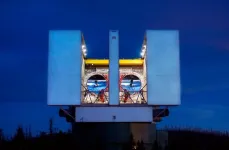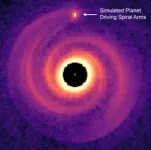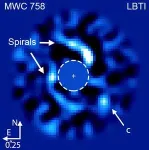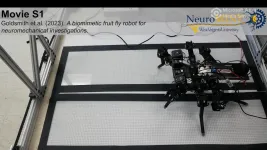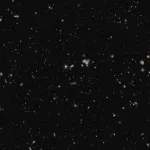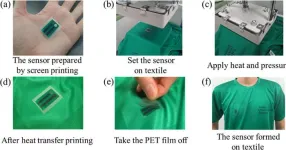(Press-News.org) Depictions of the Milky Way show a coiling pattern of spiral "arms" filled with stars extending outward from the center. Similar patterns have been observed in the swirling clouds of gas and dust surrounding some young stars – planetary systems in the making. These so-called protoplanetary disks, which are the birthplaces of young planets, are of interest to scientists because they offer glimpses into what the solar system may have looked like in its infancy and into how planets may form in general. Scientists have long thought that spiral arms in these disks could be caused by nascent planets, yet none had been detected until now.
In a paper published in Nature Astronomy, University of Arizona researchers report the discovery of a giant exoplanet, dubbed MWC 758c, that may be generating the spiral arms in its infant planetary system. The UArizona astronomers also propose possibilities as to why scientists have struggled to find this planet in the past, as well as how their methods may apply to detecting other concealed planets in similar circumstances.
"Our study puts forward a solid piece of evidence that these spiral arms are caused by giant planets," said Kevin Wagner, lead author of the paper and a postdoctoral researcher at the UArizona Steward Observatory. "And with the new James Webb Space Telescope, we will be able to further test and support this idea by searching for more planets like MWC 758c."
The planet's star is located about 500 light-years away from Earth and is only a few million years old – an embryo compared to our own 4.6-billion-year-old sun. Hence, the system still has a protoplanetary disk, as it takes about 10 million years for the circling debris to either be ejected out of the system, ingested by the star, or formed into planets, moons, asteroids and comets. The prominent spiral pattern in this system's debris was first discovered in 2013, and astronomers were quick to point out the connection to theoretical simulations of forming giant planets.
"I think of this system as an analogy for how our own solar system would have appeared less than 1% into its lifetime," Wagner said. "Jupiter, being a giant planet, also likely interacted with and gravitationally sculpted our own disk billions of years ago, which eventually led to the formation of Earth."
Astronomers have imaged most of the protoplanetary disks in stellar systems that are visible using current telescopes. Out of about 30 identified disks, around one-third feature spiral arms – prominent swirls within the gas and dust particles of the disk.
"Spiral arms can provide feedback on the planet formation process itself," Wagner said. "Our observation of this new planet further supports the idea that giant planets form early on, accreting mass from their birth environment, and then gravitationally alter the subsequent environment for other, smaller planets to form."
Spiral arms are generated due to the orbiting companion's gravitational pull on the material orbiting the star. In other words, the presence of a massive companion, such as a giant planet, was expected to trigger the spiral pattern in the disk. However, previous attempts to detect the responsible planet have turned up empty – until now.
"It was an open question as to why we hadn't seen any of these planets yet," Wagner said. "Most models of planet formation suggest that giant planets should be very bright shortly after their formation, and such planets should have already been detected."
The UArizona researchers were finally able to detect MWC 758c by using the Large Binocular Telescope Interferometer, or LBTI, a UArizona-built instrument connecting the telescope's two 8.4-meter primary mirrors that can observe at longer wavelengths in the mid-infrared range, unlike most other instruments used for observing exoplanets at shorter, or bluer, wavelengths. According to Steve Ertel, a co-author on the paper and LBTI lead instrument scientist, the instrument has a camera that can detect infrared light in a similar manner to NASA's James Webb Space Telescope, or JWST.
Even though the exoplanet is estimated to be at least twice the mass of Jupiter, it was invisible to other telescopes because of its unexpected red color – the "reddest" planet ever discovered, Ertel said. Longer, redder wavelengths are more difficult to detect than shorter wavelengths because of the thermal glow of Earth's atmosphere and the telescope itself. The LBTI is among the most sensitive infrared telescopes yet constructed and due to its larger size, can even outperform JWST for detecting planets very close to their stars, such as MWC 758c.
"We propose two different models for why this planet is brighter at longer wavelengths," Ertel said. "Either this is a planet with a colder temperature than expected, or it is a planet that's still hot from its formation, and it happens to be enshrouded by dust."
"If there is a lot of dust surrounding this planet, the dust will absorb shorter wavelengths, or bluer light, making the planet appear bright only at longer, redder wavelengths," said co-author Kaitlin Kratter, a UArizona theoretical astrophysicist. "In the other scenario of a colder planet surrounded by less dust, the planet is fainter and emits more of its light at longer wavelengths."
Wagner said large amounts of dust in the planet's vicinity may tip off that the planet is still forming, and that it might be in the process of generating a system of moons like the Jovian moons around Jupiter. On the flip side, if the planet follows the colder model, there might be something going on in these early stellar systems that causes planets to form colder than expected, prompting planetary scientists to revise their planet formation models and exoplanet detection strategies.
"In either case, we now know that we need to start looking for redder protoplanets in these systems that have spiral arms," Wagner said.
The UArizona astronomers anticipate that once they observe the giant exoplanet with the James Webb Space Telescope, they will be able to make a judgement call as to which of the two scenarios is playing out in the infant system. The team has been granted time to use JWST in early 2024 to complete these observations.
"Depending on the results that come from the JWST observations, we can begin to apply this newfound knowledge to other stellar systems," Wagner said, "and that will allow us to make predictions about where other hidden planets might be lurking and will give us an idea as to what properties we should be looking for in order to detect them."
END
Astronomers discover elusive planet responsible for spiral arms around its star
University of Arizona researchers have discovered a young exoplanet that could explain this phenomenon and provide clues about planetary formation.
2023-07-06
ELSE PRESS RELEASES FROM THIS DATE:
New single-cell study provides novel insights into gastric cancer
2023-07-06
HOUSTON – A new study led by researchers at The University of Texas MD Anderson Cancer Center provides a deeper understanding of the evolution of the tumor microenvironment during gastric cancer progression. Highlights of the study, published today in Cancer Cell, include a link between multicellular communities and clinical outcomes as well as a potential new therapeutic target.
Gastric adenocarcinoma is one of the most lethal cancers worldwide due to inherent treatment resistance, but the cellular and molecular mechanisms involved in the progression from early pre-cancer to tumor formation and metastasis are not well understood. This research sheds light on how the various ...
PLOS to extend accessible data to more articles and repositories
2023-07-06
SAN FRANCISCO — PLOS today is announcing that it has extended the scope of its “Accessible Data” experiment, which was first launched in March 2022, with support from a Wellcome Trust grant. The experimental “Accessible Data” feature is designed to increase research data sharing and reuse by highlighting links to select repositories with an eye-catching icon on the article page. We are now expanding from the original three repositories to nine, which together host about three quarters of the outputs linked to from PLOS articles.
PLOS began its Accessible Data experiment with two overarching goals. First, to increase reuse of datasets linked to PLOS articles ...
Big robot bugs reveal force-sensing secrets of insect locomotion
2023-07-06
Researchers have combined research with real and robotic insects to better understand how they sense forces in their limbs while walking, providing new insights into the biomechanics and neural dynamics of insects and informing new applications for large legged robots.
Campaniform sensilla (CS) are force receptors found in the limbs of insects that respond to stress and strain, providing important information for controlling locomotion. Similar force receptors exist in mammals known as Golgi tendon organs, suggesting that understanding the role ...
How dietary restraint could significantly reduce effects of genetic risk of obesity
2023-07-06
Obesity risk genes make people feel hungrier and lose control over their eating, but practicing dietary restraint could counteract this.
New research by University of Exeter, Exeter Clinical Research Facility, and University of Bristol – funded by the Medical Research Council Doctoral Training Partnership and published in the International Journal of Epidemiology - found that those with higher genetic risk of obesity can reduce the effects that are transmitted via hunger and uncontrolled eating by up to half through dietary restraint.
Psychology PhD student, Shahina Begum, from the University of Exeter is lead author and said: “At a time when high ...
Webb Telescope detects most distant active supermassive black hole
2023-07-06
Researchers have discovered the most distant active supermassive black hole to date with the James Webb Space Telescope (JWST). The galaxy, CEERS 1019, existed about 570 million years after the big bang, and its black hole is less massive than any other yet identified in the early universe.
In addition to the black hole in CEERS 1019, the researchers identified two more black holes that are on the smaller side and existed 1 billion and 1.1 billion years after the big bang. JWST also identified eleven galaxies that existed when the universe was 470 million to 675 million years old. The evidence was provided ...
Unveiling the secret of viruses-bacteria interactions in man-made environments
2023-07-06
Viruses in man-made environments cause public health concerns, but they are generally less studied than bacteria. A recent study led by environmental scientists from City University of Hong Kong (CityU) provided the first evidence of frequent interactions between viruses and bacteria in man-made environments. It found that viruses can potentially help host bacteria adapt and survive in nutrient-depleted man-made environments through a unique gene insertion.
By understanding these virus–bacteria interactions and identifying the possible spread of antibiotic ...
ASBMB weighs in on changes to NIH fellowship review
2023-07-06
The American Society for Biochemistry and Molecular Biology sent feedback in June to the National Institutes of Health about its proposed changes to the Ruth L. Kirschstein National Research Service Award fellowship application and review process.
The proposed changes indicate that the NIH adopted nearly all of the ASBMB’s earlier recommendations (here and here) to reduce institutional and investigator bias and refocus the evaluation on an applicant’s potential and the impact of the ...
Wastewater monitoring could act as pandemic early warning system
2023-07-06
Wastewater monitoring could act as an early warning system to help countries better prepare for future pandemics, according to a new study.
An international collaboration involving Murdoch Children’s Research Institute, The Rockefeller Foundation, Mathematica and the United Kingdom’s Health Security Agency has shed light on how different countries monitor wastewater during infectious diseases outbreaks and where improvements could be made.
For the study, samples from treatment plants, rivers, wetlands and open drains were reported ...
T cells require healthy “power plants”
2023-07-06
All cells have their own power plants, called mitochondria. There are often more than 100 mitochondria per cell and each possesses their own genome, which in turn contains genes responsible for energy production. If errors creep into these genes, this can cause problems in the cell and result in diseases. Scientists from the Berlin Institute of Health at Charité (BIH) and the Max Delbrück Center have now discovered that the T cells of the immune system are especially sensitive to genetic disturbances within their mitochondrial power plants. They have published their findings ...
Sweat it out: Novel wearable biosensor for monitoring sweat electrolytes for use in healthcare and sports
2023-07-06
The remarkable level of miniaturization possible in modern electronics has paved the way for realizing healthcare devices previously confined to the realm of science fiction. Wearable sensors are a prominent example of this. As the name suggests, these devices are worn on the body, usually directly on the skin. They can monitor important bodily parameters, including heart rate, blood pressure, and muscle activity.
Some wearable sensors can also detect chemicals in bodily fluids. For instance, sweat biosensors ...
LAST 30 PRESS RELEASES:
Do hormones explain why women experience more gut pain?
New materials conduct ions in solids as easily as in liquids
Breakthrough of the Year: Renewable energy begins to eclipse fossil fuel-based sources
LLM use is reshaping scientific enterprise by increasing output, reducing quality and more
Introducing LightGen, a chip for ultra-fast, ultra-efficient generative AI
Astronomers see fireworks from violent collisions around nearby star
ACC/AHA issue new guideline on managing congenital heart disease in adults
Cosmic crash caught on camera
Is talented youth nurtured the wrong way? New study shows: top performers develop differently than assumed
Ants: An untapped resource in the development of antibiotics?
Archaeologists use AI to create prehistoric video game
Mitochondria migrate toward the cell membrane in response to high glucose levels
Tiny viral switch offers hope against drug-resistant bacteria
Most parents aware of early peanut introduction guidelines, but confused about details
HPV vaccine can protect against severe lesions of the vulva and vagina
Virtual care provision and emergency department use among children and youth
Quadrivalent HPV vaccine and high-grade vulvovaginal lesions
Insights into dry eyes gained from stem cell-derived tear glands
Researchers identify 166 human pluripotent stem cell lines available for use in clinical applications
Europa Clipper instrument uniquely observed interstellar comet 3I/ATLAS
UN University Report challenges climate change as sole trigger of Syrian Civil War, exposing governance failures in drought response
Real estate investment trust (REIT) acquisition associated with hospital closure and bankruptcy
New Raman imaging system detects subtle tumor signals
Boston Children’s receives a $7.5 million grant from Aligning Research to Impact Autism (ARIA) to provide clinical research coordination for the IMPACT Network
Spray-on antibacterial coating offers new protection for plants against disease and drought
ESMT Berlin study: What makes a first offer successful in negotiations
Groundbreaking ceremony marks the beginning of CTAO-South Array construction in Chile
Why swearing makes you stronger
What prevents more cancer patients from enrolling in potentially life-saving clinical trials?
UK’s worst-case climate risks laid bare for lawmakers
[Press-News.org] Astronomers discover elusive planet responsible for spiral arms around its starUniversity of Arizona researchers have discovered a young exoplanet that could explain this phenomenon and provide clues about planetary formation.
